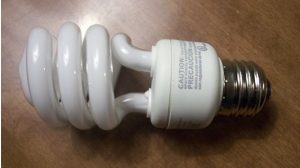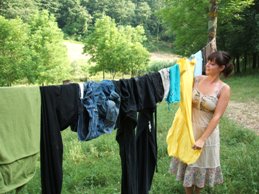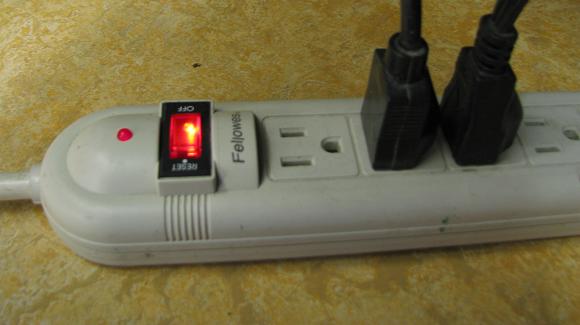 Are you taking the 1% electricity challenge? (Read about the challenge here) Here are some easy tips to help you cut your electricity use:
Are you taking the 1% electricity challenge? (Read about the challenge here) Here are some easy tips to help you cut your electricity use:
- Switch over a conventional light bulb to a CFL – (but remember to recycle them)
- Retire your extra refrigerator
- Attach electronics to power bars
 Get a drying rack or clothes line
Get a drying rack or clothes line- Use tumble dryer balls to reduce drying time
- Turn off lights not in use
- Only fill your kettle with enough water for the drinks that you are making
- Use a microwave for reheating
- Replace appliances with Energy Star recommended products
- Change your air filters regularly, reducing strain on the electric fan on your furnace
- Unplug your cell phone charger
- Turn down water heater temperature to 50 C
- Insulate your water heater and hot water pipes
- Get Manitoba Hydro’s water saver kit. Reducing water consumption also saves electricity.
- Turn off your dishwasher’s drying cycle to allow dishes to air dry.
- Send us your suggestions to this list!
Sign our petition to Manitoba Hydro CEO, Scott Thomson.




Common symptoms of mercury poisoning include peripheral neuropathy (presenting as paresthesia or itching, burning or pain), skin discoloration (pink cheeks, fingertips and toes), swelling, and desquamation (shedding of skin).:;”^
Most current short article produced by our very own website <http://livinghealthybulletin.com
We need to conserve energy, but beware of just putting those savings into bigger houses with more appliances: http://www.treehugger.com/energy-efficiency/new-more-efficient-us-homes-eat-much-energy-they-did-decade-ago-because-they-are-30-larger.html
Try making a solar oven! See the picture: http://www.facebook.com/photo.php?fbid=479860072050772&set=a.465158423520937.94413.465153460188100&type=1&theater
I am opposed to promoting (Mercury) CFL’s . They have no proper way of recycling this harmful product
Note that Home Depot and Rona have been collecting flourescent lights for recycling for years. And a new Product Care program to extend recycling opportunities was initiated last May. (See http://www.gov.mb.ca/conservation/pollutionprevention/hhw.html). Mercury can be stabilized readily by treatment with sulfur dust (http://en.wikipedia.org/wiki/Fluorescent_lamp_recycling). So the main issues are to insure that bulbs are put in the recycling stream rather than the waste stream and that broken bulbs are handled with care.
Our household agrees with the dangers of the CFL”s and are stocking up since last year as money permits. we also practise unplugging any devices not in use .ie. a/c,washer, lamps electronics, computers-saves from powersurges in addition to blackout damaging powercells as we previuosly experienced. By unplugging for almost a year, we had a elec. credit for 5 months! good luck to all of us and let us keep those clotheslines in every neighborhood .
We recognize that CFLs contain dangers, and are not applicable in all situations. I wrote a resource page on the dangers and benefits of using them, and was quoted on the CBC National about the issues around lack of recycling facilities last year. https://greenactioncentre.ca/content/compact-florescent-lamps/ However, our position is that used correctly, CFLs can be a tool for energy conservation in some situations.
Regarding the idea that conventional light bulbs can be a relatively efficient source of heat in the winter, this is only the case if you are normally using electric heat, and the lights are efficiently placed, e.g. not near the ceiling.
If you choose not to switch to CFLs, there are still lots of other ideas you can choose to reduce your electric consumption.
Peter, as per your instruction, I must correct your point on Manitoba having “electricity that is created with no mercury pollution” as this is not true. There is a type of mercury (some mercury-containing compound) that exist naturally in soils in Manitoba (and presumably other places) and is stable in the soil until the soil is flooded by, for instance, a hydroelectric dam. The mercury leaches out into the water and is absorbed by the little plants that grow on the bottom of the newly created lake. The plants are eaten by little creatures that in turn are eaten by fish. People who eat these fish can develop mercury poisoning through the effects of bio-magnification, bio-accumulation, etc., so a risk still exists. As for the relative risk, my guess is that we are still better off with the dams and incandescent lights instead of coal fired power plants and CFLs, but I do not know for certain. Either way, I am likely stocking up on incandescent bulbs if they actually are going to ban them in January 2013 because I would rather suffer from other things besides mercury poisoning.
Hi Josh,
Switching over to CFL’s may not be the most environmentally responsible thing to do. Much of the benefit of CFL’s have to do with using energy from coal fired power plants. Because burning coal releases mercury, the amount of mercury contained in a CFL is offset by a reduction in coal emissions. However in MB where we have electricity that is created with no mercury pollution, (correct me if I’m wrong on that) using a CFL unnecessarily brings mercury pollution into our province. Much of it going into the landfill, and some directly into our homes (when bulbs break). Also given that the excess energy used by an incandescent is given off in heat, any time that your furnace is heating your home the net energy gain by switching to a CFL is 0.
In these days of increased chemical exposure and with some people experiencing toxic effects and extreme chemical sensitivities, perhaps we should consider CFLs an unnecessary risk. Especially in MB where we have clean energy (in regards to air pollution) and a cold climate.